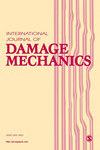Micro-damage instability mechanisms in composite materials: Cracking coalescence versus fibre ductility and slippage
IF 3.9
2区 工程技术
Q2 MATERIALS SCIENCE, MULTIDISCIPLINARY
引用次数: 0
Abstract
The load-displacement softening response of quasi-brittle solids exhibits an unstable structural behavior, which is characterised by a negative slope in the post-peak regime. In severely brittle situations, the post-peak behaviour can show a virtual positive slope, the fracture propagation occurring unexpectedly with a catastrophic loss in the load-carrying capacity. In this case, if the displacement controls the loading process, the curve exhibits a discontinuity and the representative point drops to the lower branch with a negative slope. On the other hand, in order to obtain a stable crack growth, a decrease both in load and in displacement is required. In the last forty years, in-depth study of the so-called snap-back instability was conducted in relation to crack propagation phenomena in quasi-brittle materials. In the present work, the structural response of two brittle-matrix specimens is analysed: the first contains a distribution of collinear micro-cracks, whereas the second presents multiple parallel reinforcing fibres embedded in the matrix. In both cases, it is shown that the structural response presents a discrete number of snap-back instabilities with related peaks and valleys, the crack propagation occurring alternately within the matrix and through the heterogeneities. Thus, the strong analogy between weakened and strengthened zones consists in a multiple snap-back mechanical response, where descending branches of propagating cracks alternate with ascending (linear) branches of arrested cracks.复合材料中的微损伤不稳定机制:裂纹凝聚与纤维延展性和滑移
准脆性固体的荷载-位移软化响应表现出一种不稳定的结构行为,其特征是峰值后状态的负斜率。在严重脆化的情况下,后峰值行为会出现虚拟正斜率,断裂扩展会意外发生,并导致承载能力的灾难性损失。在这种情况下,如果位移控制加载过程,曲线就会出现不连续性,代表点会下降到负斜率的下分支。另一方面,为了获得稳定的裂纹增长,需要同时降低荷载和位移。在过去的四十年中,针对准脆性材料中的裂纹扩展现象,对所谓的回弹不稳定性进行了深入研究。本研究分析了两种脆性基体试样的结构响应:第一种试样含有分布不均的微裂纹,而第二种试样则是基体中嵌入了多条平行的增强纤维。结果表明,在这两种情况下,结构响应都呈现出数量离散的回弹不稳定性,并伴有相关的峰值和谷值,裂纹在基体内和通过异质性交替传播。因此,弱化区和强化区之间的强烈类比性在于多重折返机械响应,即传播裂纹的下降分支与停止裂纹的上升(线性)分支交替出现。
本文章由计算机程序翻译,如有差异,请以英文原文为准。
求助全文
约1分钟内获得全文
求助全文
来源期刊

International Journal of Damage Mechanics
工程技术-材料科学:综合
CiteScore
8.70
自引率
26.20%
发文量
48
审稿时长
5.4 months
期刊介绍:
Featuring original, peer-reviewed papers by leading specialists from around the world, the International Journal of Damage Mechanics covers new developments in the science and engineering of fracture and damage mechanics.
Devoted to the prompt publication of original papers reporting the results of experimental or theoretical work on any aspect of research in the mechanics of fracture and damage assessment, the journal provides an effective mechanism to disseminate information not only within the research community but also between the reseach laboratory and industrial design department.
The journal also promotes and contributes to development of the concept of damage mechanics. This journal is a member of the Committee on Publication Ethics (COPE).
 求助内容:
求助内容: 应助结果提醒方式:
应助结果提醒方式:


